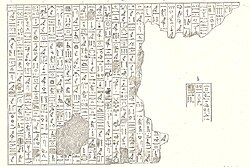The Tenth Dynasty of ancient Egypt (Dynasty X) is often combined with the 7th, 8th, 9th and early 11th Dynasties under the group title First Intermediate Period.[1]
Tenth Dynasty of Egypt | |||||||||||
|---|---|---|---|---|---|---|---|---|---|---|---|
| ca. 2130 BC–ca. 2040 BC | |||||||||||
 | |||||||||||
| Capital | Herakleopolis Magna | ||||||||||
| Common languages | Egyptian language | ||||||||||
| Religion | ancient Egyptian religion | ||||||||||
| Government | Absolute monarchy | ||||||||||
| Historical era | Bronze Age | ||||||||||
• Established | ca. 2130 BC | ||||||||||
• Disestablished | ca. 2040 BC | ||||||||||
| |||||||||||
Rulers
editThe 9th Dynasty was founded at Herakleopolis Magna, and the 10th Dynasty continued there. At this time Egypt was not unified, and there is some overlap between these and other local dynasties. The Turin Canon lists eighteen kings for this royal line, but their names are damaged, unidentifiable, or lost.[2]
The following is a possible list of rulers of the Tenth Dynasty based on the Turin Canon, as Egyptologists have differing opinions about the order of succession within the two dynasties. Among them, only Wahkare Khety and Merykare are undoubtedly attested by archaeological finds:
| Name | Image | Comments |
|---|---|---|
| Meryhathor(?) | Existence doubtful, known from a damaged graffito at Hatnub | |
| Neferkare VIII | Might be the Kaneferre mentioned in the tomb of the nomarch Ankhtifi | |
| Wahkare Khety III | Possibly the purported author of the Teaching for King Merykare | |
| Merykare | Main opponent of the Theban pharaoh Mentuhotep II | |
| [name lost] | An ephemeral ("x months") successor of Merykare |
References
edit- ^ Shaw, Ian, ed. (2000). The Oxford History of Ancient Egypt. Oxford University Press. p. 480. ISBN 0-19-815034-2.
- ^ Sir Alan Gardiner, Egypt of the Pharaohs, Oxford University Press, 1961, pp. 112-13.
- ^ William C. Hayes, in The Cambridge Ancient History, vol 1, part 2, 1971 (2008), Cambridge University Press, ISBN 0-521-077915, p. 996.